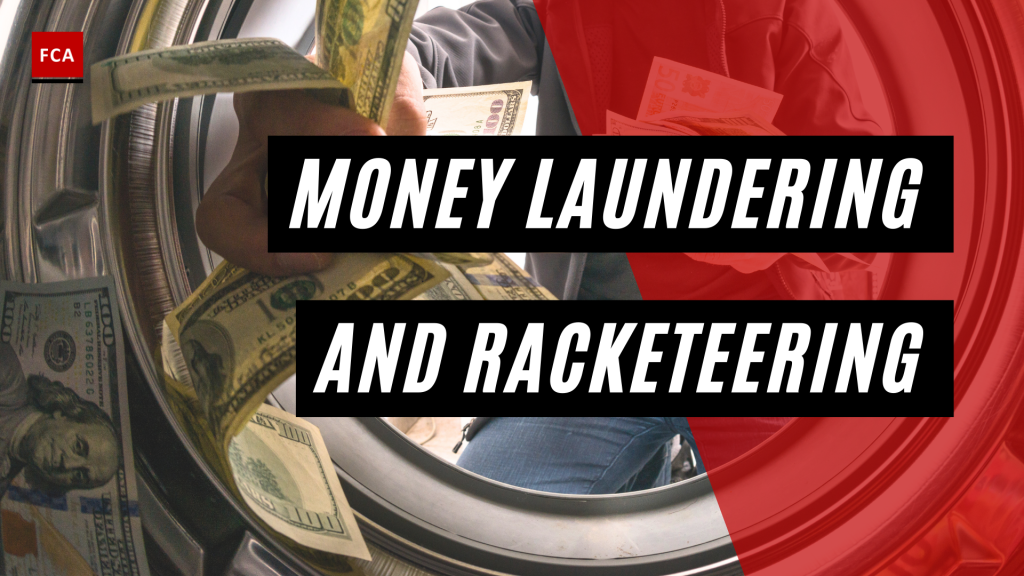Money laundering and racketeering might sound like something out of a thrilling crime novel, but these illicit activities have real-world consequences. Unraveling the intricate web of financial transactions and organized crime is no easy task. However, understanding the ins and outs of these two interconnected phenomena can shed light on how they operate and impact society. In this blog post, we will delve into money laundering and racketeering, explore their connection, examine legal defenses against charges, and discuss real-world examples of these crimes. Are you ready for a deep dive into the shadowy world of money laundering and racketeering? Let’s begin.
Key Takeaways
Money laundering is the process of disguising illegally obtained funds, and carries hefty penalties if detected.
Racketeering involves a range of criminal activities subject to prosecution under the RICO Act with devastating impacts on society.
Money laundering is often used by criminal enterprises to conceal proceeds from racketeering activities and finance Crimes without detection.
Exploring Money Laundering

Money laundering refers to the act of masking the origins of illicitly gained money, typically linked to drug offenses and other criminal endeavors like racketeering, corruption in public relations, and systematic fraud. This dark art involves the use of shell companies, false invoicing, and offshore accounts to make it appear as if the funds came from legitimate sources.
Money laundering carries heavy consequences, with penalties reaching a 20-year imprisonment or fines up to $500,000 or twice the laundered amount, contingent on the crime’s severity.
The Stages of Money Laundering
Money laundering typically unfolds in three stages:
Placement: illegal funds are introduced into the financial system.
Layering: the origin of the funds is concealed by transferring them through multiple accounts and transactions.
Integration: the laundered funds are incorporated back into the legitimate financial system, appearing as legitimate funds.
These stages are designed to confuse and mislead, making it increasingly difficult for law enforcement to trace the true source of the funds.

Money Laundering Penalties and Consequences
Money laundering incurs harsh penalties, potentially leading to a 20-year jail term and fines amounting to $500,000 or twice the laundered value. These stiff penalties are in place not only to deter would-be money launderers but also to address the significant harm caused by their actions. The severity of these penalties reflects the grave nature of money laundering as a crime, which not only fuels other criminal activities but also undermines the integrity of financial systems worldwide. The process of money laundering often involves a complex network of transactions across multiple countries, making it a challenging crime to detect and prosecute. The high penalties serve as a strong deterrent, sending a clear message about the seriousness with which such crimes are regarded. Furthermore, the damage caused by money laundering extends beyond immediate financial loss. It can erode public trust in financial institutions, disrupt economies, and even contribute to social instability. Therefore, the high penalties are seen as necessary to reflect the extensive damage that money laundering can cause to societies and economies around the globe.
Money laundering is often associated with organized crime groups, and the funds laundered through these activities can be used to finance further criminal activities, perpetuating a cycle of crime and corruption.
Delving into Racketeering

Contrarily, racketeering embodies a broad spectrum of criminal offenses, such as extortion, fraud, and coercion. The Racketeer Influenced and Corrupt Organizations Act (RICO) provides prosecution against organizations engaging in criminal activities. This act is strictly enforced by the legal system. Racketeering activities can be diverse and elaborate, with criminals employing various tactics and schemes to further their illegal enterprises.
From drug trafficking to illegal gambling, racketeering can have far-reaching consequences on society and the economy.
Common Racketeering Activities
Some examples of racketeering activities include:
Drug trafficking
Illegal gambling
Bribery
Ponzi schemes
Predatory lending
Payment card fraud
Securities fraud
Insider trading
Engaging in illicit activities, which essentially means to commit illegal acts, not only causes significant harm to individuals and businesses but also undermines the integrity of financial markets and institutions due to the prevalence of illegal acts.

RICO Act and Its Impact on Racketeering
Passed by Congress in 1970, the RICO Act is a federal law designed to battle organized crime. Under the RICO Act, a wide range of criminal activities is considered racketeering, including:
bribery
various fraud offenses
gambling offenses
money laundering
many financial and economic crimes
To convict someone of federal crimes, specifically racketeering charges, prosecutors must demonstrate a pattern of racketeering activity, which is defined as at least two acts of racketeering activity within a specified period.
The RICO Act has had a significant impact on the prosecution of racketeering cases. By allowing the government to target entire criminal organizations, the RICO Act has led to the prosecution and dismantling of numerous criminal enterprises. In addition to criminal penalties, the RICO Act also provides for the seizure of assets and civil actions against those involved in racketeering activities. This comprehensive approach to combating racketeering has been instrumental in disrupting the operations of many criminal organizations and reducing the prevalence of racketeering-related crimes.
The Connection Between Money Laundering and Racketeering

Money laundering and racketeering are often interconnected, with criminal enterprises using money laundering to legitimize their illicit profits. As mentioned earlier, money laundering involves the concealment of illegally obtained funds, often associated with drug crimes and other criminal activities.
In the context of racketeering, money laundering is frequently utilized to conceal the proceeds of the criminal activities and incorporate them into the legitimate economy. This allows criminal enterprises to finance further criminal activities and evade detection by law enforcement.
How Criminal Enterprises Use Money Laundering
Criminal organizations use money laundering as a means to:
Hide the proceeds of their racketeering activities
Maintain their operations
Conceal the proceeds of their illicit activities
Integrate the funds into the legitimate economy
Obscure the source of their funds
Evade detection by law enforcement.
Furthermore, money laundering facilitates the use of their profits to finance additional criminal activities, perpetuating a cycle of crime and corruption.
Combating Money Laundering and Racketeering

An illustration showing the process of money laundering and racketeering with multiple hands exchanging cash and documents.](https://images.surferseo.art/2850e2c4-8a97-4be6-85e4-53b1f6ac3fcb.webp)Law enforcement agencies employ a range of tools and strategies, including criminal investigation, to address money laundering and racketeering. Financial investigations are employed to ascertain and trace the progression of funds through the financial system, which can assist law enforcement entities in recognizing and bringing to justice those implicated in money laundering and racketeering.
In these financial investigations, law enforcement agencies often utilize advanced data analysis tools to trace the intricate network of transactions involved in money laundering. They also collaborate with financial institutions, which are required by law to report suspicious activities that could be indicative of money laundering or racketeering. Furthermore, law enforcement agencies often work in tandem with international partners, as these crimes frequently involve cross-border transactions. This global collaboration enhances the ability to trace funds back to their illicit source and apprehend those involved in these complex crimes.
The use of technology in these investigations cannot be understated. Advanced software can detect patterns and anomalies in financial data that would be nearly impossible for humans to identify. This technology is continually evolving to stay ahead of the sophisticated techniques employed by money launderers and racketeers.
In addition to investigations, law enforcement agencies also engage in prevention efforts, such as public education campaigns and training for financial professionals. By increasing public awareness of these crimes and their societal impact, and by enhancing the ability of financial professionals to detect suspicious activity, law enforcement agencies aim to deter potential offenders and reduce the prevalence of these crimes.
Additionally, international cooperation is indispensable in the fight against money laundering and racketeering, as it facilitates the exchange of information and resources between law enforcement agencies across borders.
Legal Defenses Against Money Laundering and Racketeering Charges

Legal defenses against money laundering and racketeering charges can be quite complex and varied, ranging from challenging the evidence to proving lack of intent. As these charges can carry severe penalties, it is essential for those accused to have a solid understanding of the legal defenses available to them and to seek the assistance of an experienced attorney.
Challenging Evidence and Proving Intent
Defense strategies in money laundering and racketeering cases may involve disputing the validity of evidence, demonstrating a lack of criminal intent, or proving that the accused was not part of a criminal enterprise. To challenge the evidence, the defense can contest the chain of custody, question the accuracy of the evidence, or argue that the evidence was obtained unlawfully, potentially obstructing justice.
To demonstrate a lack of intent, the defense can show that the accused was unaware of the criminal activity, had no knowledge of the source of the money, or was acting under duress. Proving that the accused was not part of a criminal enterprise may involve showing that the accused was not aware of the criminal activity, was not involved in planning or executing the crime, and was not in a position to benefit from the criminal activity.
Navigating Federal Court Proceedings
Experienced attorneys can help defendants navigate the complexities of federal court and develop a strong defense strategy. The process of navigating federal court proceedings includes steps such as:
Investigation
Charging
Initial hearings
Trial
This process requires adherence to the Federal Rules of Practice and Procedure, which govern the conduct of trials, appeals, and cases under Title 11 of the United States Code.
Having an experienced attorney on your side can ensure that your rights are upheld throughout the process and increase the likelihood of a favorable outcome.
Real-World Examples of Money Laundering and Racketeering Cases

Real-world examples of money laundering and racketeering cases can provide valuable insight into the severity and scope of these crimes. From notorious drug lords to high-profile financial scandals, these cases demonstrate the far-reaching consequences of money laundering and racketeering on society, the economy, and individual lives.
High-Profile Money Laundering Cases
Some high-profile money laundering cases include the Panama Papers scandal, in which confidential documents from the Panamanian law firm Mossack Fonseca revealed the use of offshore companies to hide wealth and evade taxes.
Another notable case is the HSBC money laundering case, where the British banking giant was accused of facilitating the laundering of billions of dollars for Mexican drug cartels and other criminal organizations, leading to a significant fine for the bank.
Infamous Racketeering Cases
Infamous racketeering cases involve figures such as John Gotti and the Gambino crime family, who were found guilty of racketeering charges in 1992 and subsequently dissolved as a criminal organization. Another example is the Teamsters union in the 1920s, which was infiltrated by organized crime and became a breeding ground for racketeering activities, leading to a series of high-profile convictions.
These cases highlight the devastating impact that racketeering can have on individuals, businesses, and entire communities.
Summary and Conclusion

This article has delved into the intricacies of money laundering and racketeering, scrutinizing their interconnection, legal defenses, and actual case examples. As we have seen, these illicit activities can have far-reaching consequences on society, the economy, and individual lives.
Gaining an understanding of the intricacies of money laundering and racketeering allows us to comprehend the significance of law enforcement endeavors to fight these crimes and the necessity of persisting vigilance to protect our financial systems and communities. It is our hope that this deeper understanding will inspire continued efforts to prevent and prosecute these destructive criminal activities.
Frequently Asked Questions
In this section, we will address some frequently asked questions regarding money laundering and racketeering, providing additional insight into these complex and interconnected criminal activities.
What is the relationship between money laundering and crimes?
Money laundering has strong ties to many criminal activities, as culprits often use it to hide the illicit origins of their profits. By obscuring the origin of illicitly obtained funds, money laundering makes it more difficult for law enforcement to trace the funds back to the initial criminal activity.
Examples of crimes related to money laundering include trafficking, illegal wildlife trade, green crime, corruption, and cybercrime.
What is considered money laundering?

Money laundering involves obscuring the origins of illicitly gained funds by channeling them through a complex sequence of financial transactions. The process typically involves three steps:
Placement: illegal funds are introduced into the financial system.
Layering: funds are transferred through a series of transactions to conceal their source.
Integration: laundered funds are reintroduced into the legitimate economy, appearing as legitimate funds.
What is the best example of money laundering?
One of the most notorious instances of money laundering involves Mexican drug lord Joaquin “El Chapo” Guzman, who allegedly used a convoluted network of shell companies and offshore accounts to hide the proceeds from his drug trafficking operations.
This case highlights the complexity and sophistication of money laundering schemes and the challenges faced by law enforcement in combating this illicit activity.
Is money laundering theft?
Unlike theft, money laundering doesn’t involve directly taking money from another person or entity. Instead, it focuses on concealing the proceeds of unlawful activities as legitimate funds. While both crimes involve the misappropriation of funds, money laundering focuses on disguising the source of those funds to evade detection and prosecution, whereas theft involves the direct taking of property from its rightful owner.








